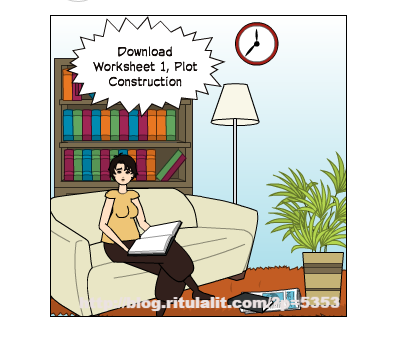Plotting a story Part 2
 My first blog post on plotting a story was met with a lot of appreciation. Thank you. Plots are hard to come by since a certain damadji cornered all of them.
My first blog post on plotting a story was met with a lot of appreciation. Thank you. Plots are hard to come by since a certain damadji cornered all of them. 
Kidding.
I am currently living through a season of false starts. I write a few chapters of a novel and discard it because the plot does not inspire me any more. If I don’t find the plot inspiring, if I can’t live through the process of writing, how can I dish it out for readers? They’ll reject it in a fraction of a second.
Plots!
Even the old Hindi verse Ek tha raja, ek thi raani, dono mar gaye, khatam kahani is a story – with a plot. Loosely translated it means There once was a king, there once was a queen, both died, end of story. Weak plot, but plot, nevertheless …
Like I said earlier, every story has been written, there is no new story. The game writers play is vary the presentation, embellish it with the best prose they can, spice it up. More like cooks dreaming up fresh new ways to serve up a dish of new potatoes. I referred to it in my previous post as “layering.” Starting a project blind, without knowing where it is going to go leads to a lot of effort being wasted. I should know, my laptop right now is full of carcasses of dead novels, a few chapters here, some passages there and a completely obscure finished novel which confuses me. I was smoking some potent stuff while writing it, I guess, because even I don’t know what its trying to say.
This led to me thinking of a blueprint to chart my novel through. The internet has many helpful plot outline tools. Being a lazy human, I tried some of those instead of making my own. But finally I had to make my own tool kit. The one I have listed below is my basic one, based on the inputs I found on the net. The good news is it worked for me. The not-so-good news is that it may or may not work for you. You can download it. It is my New Year gift to my readers
Novel Construction 1
Working Title (You can change it, no sweat. I have named projects after my pet dogs. One memorable title was “Ajooba Baron, the saga of an astonishing canine.” Yes, I know I have a weird sense of humour.
Genre : This is non-negotiable, you can’t start writing a crime thriller and change it into a chic lit. Not unless you want to go back to the beginning and change everything you wrote.
Tense/POV : Again non negotiable.
Setting : Urban, Rural, Dystopian, Space, Combat, War, Ancient, Medieval or any other … Decide before you begin.
Plot structure : The set up
The thrust : All good books begin with a defining incident, one that propels the story forward and throws both the protagonist and antagonist on to a path of collision.
The internal conflict : This is a good place to fill in details. What does your hero or heroine want? What’s stopping her from having it. Now what’s she going to do to get it?
The external conflict : Enough of the emotions, now we get to the action. What does your hero or heroine finally do to get what they want? We can add the fun part – throw in the antagonist to stop the protagonist from getting what they want.
Back-story : Here we fill in the boring details. We can, if we are writing a mystery or a thriller, withhold some vital things which we can spring on the reader later. It all depends on the genre.
Note : Great stories often begin at the thrust, throwing the main character right into the thick of things, and allow the back story to develop along the way
The Confrontation (Middle)
This is the conflict part of the story. Some authors revel in the writing of this part. I find it slightly tough. The key point of the middle is the emotional growth of the character. It has to be built up gradually through a series of conflicts. I don’t mean fights. It goes somewhat like this:-
Internal challenges or obstacles : They should be more than two but definitely less than six. Gradual build up, keep raising the stakes with every challenge until the end of the Confrontation bit of your story.
External challenges : This is your antagonist or your obstacles. Make the ultimate prize or goal very important for your hero/heroine. Make the failure for the hero/heroine very expensive. That way we have clearly defined the goal and the stakes.
Internal Higher Challenge : Should the protagonist turn back now? Why doesn’t he or she?
External higher challenge : Who or what is stopping him? Why? Spell out the reason clearly. We have to make the obstacle or antagonist lose empathy.
Highest challenge (Internal) : The hero or heroine goes to the brink, nearly gives up, but the goal is to strong. Give a strong reason here to keep the character from giving up. It helps if we give the character a flaw that comes into play here which makes it easy for the dark forces to exploit.
Highest challenge (External) : Just at the turning point, make the character lose respect or something really dear, because of the fatal flaw. The writing should be compelling enough to make the reader cheer when the character snaps and goes back to winning the prize with renewed zeal.
This point is what I call the darkest hour. (Yes I love drama.)
Metamorphosis : Spell clearly how the character, after all that he/she has gone through will never be the same again. Make him/her redeem lost object or honour by staking all to win the prize.
The Resolution
Lesson learnt (Internal) &
Prize won (External)
Have these two play out simultaneously for the classic climax.
Like I said in my previous post “Characters drive the story.” Plot is just a series of events or an adventure. To write a good book, let your focus be more on the characters than the plot. The plot has to emerge naturally from the characters to make the story believable. I love it when an author makes me nod my head and murmur “But of course!” Yes, we are writing stories, but they have to be believable and retain the reader’s empathy.
A good book makes a reader live the events and often go back to them. A good book changes the reader.
Hope this worksheet helps you and Happy New Year
 Plot Construction Worksheet 1
Plot Construction Worksheet 1
Download Now!11 Downloads



